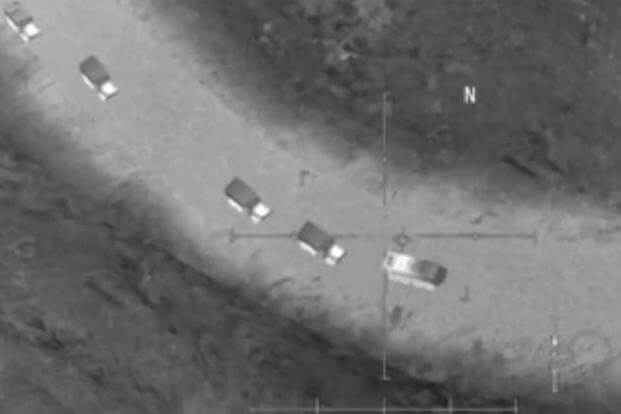"They're lies -- baseless, inaccurate and completely false."
Army Col. Ryan Dillon, a spokesman for Combined Joint Task Force-Operation Inherent Resolve, was just getting warmed up Tuesday in rejecting charges by the Russian Ministry of Defense that U.S. warplanes flew air cover for ISIS militants fleeing an attack by the forces of the Russian-backed Syrian regime.
"It's about as accurate as their air campaign," Dillon said of the Russian claim that the U.S. aided the Islamic State of Iraq and Syria in retreating from the town of Abu Kamal near the Syrian border.
Actually, ISIS fighters were still in Abu Kamal and holding off Syrian attempts to oust them, Dillon said in a video briefing from Baghdad to the Pentagon.
In addition, the Russian Ministry of Defense used two-year-old images from the video game "AC-130 Gunship Simulator" and from airstrikes in Iraq to back up their charges, Dillon said. "Anything from the Russian MOD (Ministry of Defense) is suspect," Dillon said.
"I've seen the report that one of the pictures came from a video game. So, again that is pretty consistent with what we have seen come out of Russian MoD as being baseless, inaccurate and you know, completely false," Dillon said.
The Russian MOD later said that the posting of the bogus images was the result of an error by a civilian employee, but essentially stuck by its claim that the U.S. was aiding ISIS.
"However, the U.S. command's refusal to carry out strikes on the convoys of (ISIS) terrorists retreating from Abu Kamal on November 9 is an objective fact," Russia's Interfax news agency quoted the Russian MOD as saying in a statement.
While firmly rejecting the Russian charges, Dillon was not so sure about a BBC report that the U.S. and its partnered Syrian Democratic Forces allowed hundreds of ISIS fighters and their families to evacuate the self-proclaimed ISIS capital of Raqqa before the final assault to take the city.
The U.S. has confirmed that a deal was made by the SDF to allow civilians to evacuate Raqqa on Oct. 12 before the final push that liberated the city on Oct. 20.
The lengthy BBC report cited truck drivers contracted to take out the civilians. They said that hundreds of ISIS fighters and their wives wearing suicide vests were in the convoy that included trucks loaded with weapons.
Dillon said that a U.S. advisor in a "non-active role" joined in the screening using biometric data of those leaving Raqqa by the SDF, the newly-formed Raqqa City Council and tribal elders.
Four individuals suspected of being ISIS foreign fighters were detained, Dillon said, and another 300 were identified as possible ISIS fighters.
A total of about 3,500 people came out of the city, Dillon said, and he could not confirm or deny the BBC report that hundreds of fighters and trucks loaded with weapons were among them.
"When you have thousands of people coming out of the city. I can't say with 100 percent certainty that every single fighter was identified coming out of Raqqa," Dillon said.
--Richard Sisk can be reached at Richard.Sisk@military.com.












